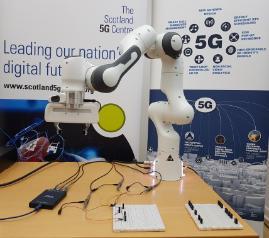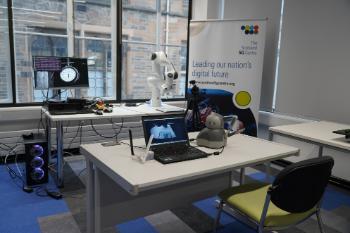Low-Latency of 5G Network Communications Utilised to Enable Real Time Remote-Controlled Robot Arm
EPSRC IAA project in collaboration with Advanced Wireless Technology Group (AWTG) and Bot-Hive.
A team from the James Watt School of Engineering, led by Prof Muhammad Imran and Dr Guodong Zhao (Principal Investigator), was awarded a six-month EPSRC Impact Acceleration Account project (£28K) in autumn 2020 to deliver a demonstrator which would utilise the low latency of 5G to enable applications to be operated remotely in real time. Such a technology has a vast potential across a myriad of applications including factory automation, robotic surgery and controlling unmanned aerial vehicles, and is the basis of several interesting use case demonstrations for the Scotland 5G Centre’s urban testbed. Working with industry collaborators AWTG and Bot-Hive, they delivered a prototype 5G teleoperation system that has been initially employed to support students’ education during remote working. To date, this demonstration has led to more than 200 students enrolled in the University’s transnational education programmes across Scotland and China engaging with the working prototype to take control of the robot arm and learn the basics of circuit design. With the robot arm located in the James Watt South Building on campus, students from anywhere around the world can log-on and program the prototype to pick up circuit components and place them in the correct position. This allows the students to remotely measure the circuit, complete the experiment, and provides them with the required skills to operate remotely in the future.
Additionally, in the short period since the award, this IAA project has led to:
- Completion of a market assessment exercise that has identified the opportunities available to this technology;
- Innovate UK funding with the VR company eComScotland (£130K);
- Collaborations within the UK (Platinum Electrical Engineering UK, UbiPOS) and internationally (Huawei) that are targeting further funding;
- A new academic collaboration (Assistant Prof Chen Wang, Louisiana State University) that has delivered one publication to date;
- Demos at IEEE Globecom and VTC 2021 conferences;
- A self-funded PhD student to start in autumn 2021.
A short video on the project can be seen below and you can read more on this work in the university news at: https://www.gla.ac.uk/news/headline_765178_en.html



